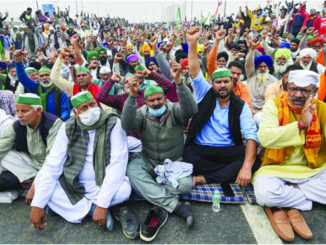

Addition of local agrarian demands into the call for the repeal of the farm laws may have forced the Government’s hand
“The Union government’s response to the protests were appalling and marked by hubris. Its focus was on controlling and positivizing the narrative. Efforts were made to break, divide, buy out, demean, denigrate, demonize and shame the protesters, who were conveniently branded as terrorists and Khalistanis. Sedition cases were filed against the protesters. Teargas shells rained on the protest marches, and officials publicly asked the police to smash the heads of protesters. In Lakhimpur Kheri, Uttar Pradesh, a vehicle was driven into a peaceful demonstration, killing several persons. That the protests endured and survived such brutal responses is indeed salutary.”
The repeal of the three farm laws by the Union government, on Friday, November 19, marks a historic victory for the farmer’s movement in India. For more than a year, thousands of farmers had barricaded Delhi, and their protests were gradually evolving into a pan-Indian movement of resistance. The belated, though wise, decision by the Government to repeal the laws brings down the curtains on the agitation in Delhi but is unlikely to douse the political fervor it has left behind. The Union government’s response to the protests were appalling and marked by hubris. Its focus was on controlling and positivizing the narrative. Efforts were made to break, divide, buy out, demean, denigrate, demonize and shame the protesters, who were conveniently branded as terrorists and Khalistanis. Sedition cases were filed against the protesters. Teargas shells rained on the protest marches, and officials publicly asked the police to smash the heads of protesters. In Lakhimpur Kheri, Uttar Pradesh, a vehicle was driven into a peaceful demonstration, killing several persons. That the protests endured and survived such brutal responses is indeed salutary.
The broader context
“Reforms” in agriculture, advocated by right-wing economists after 1991, were focused on dismantling the institutional support structures in Indian agriculture that were established after the 1960s. These support structures — in prices, subsidies, credit, marketing, research and extension — were instrumental in India’s achievement of food self-sufficiency between the 1960s and the 1980s.
In agricultural marketing, the focus of attack was the mandis governed by the Agricultural Produce Market Committee (APMC) Acts passed by State Assemblies. It was argued that if India needs to diversify its cropping pattern into export-oriented and high-value crops, mandis need to give way to private markets, futures markets and contract farming. The APMC Acts discriminated against farmers by not allowing them to interact directly with the big corporate buyers and exporters. So, the APMC Acts must be amended so that any private market or rural collection center can freely emerge anywhere without approval of the local mandi or the payment of a mandi tax, and so that contract farming can be popularized. Similarly, the advocacy for the amendment to the Essential Commodities Act, 1955 rested on the view that private corporate investment can be incentivized into storage and warehousing if stock limits are relaxed for traders. It was a long-held constitutional consensus in India that agricultural marketing was the legislative arena of State governments. Thus, in 2003, the Union government prepared a Model Act on agricultural marketing and sent it to States for passage in State Assemblies. This was followed by the preparation and circulation of two other Model Acts, in 2017 and 2018. Reception to these Model Acts was neither dismissive nor welcoming. Many States selected a few clauses, which they found attractive and suitable to their contexts, and accordingly amended their APMC Acts between 2003 and 2020. Only one State — Bihar — used the occasion to completely annul its APMC Act in 2006.
Laws were unconstitutional
The consensus was broken in 2020, when the Union government took up on itself the task of legislating on agricultural marketing and passed the farm laws. Federal principles were violated as the Union government invoked Entry 33 of the Concurrent List to intervene into matters in Entry 14, Entry 26 and Entry 27 of the State List. The farm laws even interfered with Entry 28 of the State List, which were not subject to Entry 33 of the Concurrent List. Thus, to begin with, the farm laws were reasonably and justifiably argued to be unconstitutional.
However, the Supreme Court of India refused to act swiftly on petitions filed before it. Instead, without consulting the protesting farmer’s organizations, it appointed, in January 2021, a committee of four persons, all of whom had publicly declared their support for the farm laws. Farmer’s organizations, on their part, distanced themselves from the committee and continued with their agitation.
Apart from constitutionality, the contents of farm laws were also widely criticized. Bihar’s example showed that private investment was unlikely to flow into agricultural markets even if APMC Acts were annulled. In fact, the exploitation of farmers by unscrupulous traders intensified in Bihar after 2006. Kerala never had an APMC Act.
Yet, there was little presence of private investment in its agricultural markets. Maharashtra delisted fruits and vegetables from the ambit of APMCs in 2016. Still, the inflow of private investment into agricultural markets was only marginal. Thus, what was likely was that a formal and regulated market might fragment itself into an informal and unregulated market if the APMC Acts were weakened. Furthermore, two other problems were highlighted. One, mandi taxes were used to invest in rural infrastructure in States such as Punjab. If mandis are weakened, what would substitute for such investments? Two, even if private markets emerged, how would they address the structural problem of poor farm-gate aggregation of the produce of small and marginal farmers? Would one middleman be simply substituted by another? Proponents of farm laws had no convincing answers.
The grievance redress mechanisms for contract farming also came up for criticism. The obliteration of the power of civil courts and their substitution with a weak mechanism led by the sub-divisional magistrate threatened to be a serious impediment to a just redress of complaints. It was feared that this may benefit corporate sponsors more than the contracting farmers.
It pointed towards corporates
Finally, the overall thrust of the farm laws appeared to encourage the participation of larger corporate players in agricultural markets rather than farmer-friendly organizations, such as cooperatives or Farmer Producer Companies (FPC). Especially in the case of the amendment of the Essential Commodities Act, there was reasonable suspicion that a handful of corporate players were to substantially benefit from investments in logistics, storage and warehousing.
The farmers’ protests began from States such as Punjab and Haryana where the mandis were deeply rooted institutions in the local economy and society. However, as days passed, the agitation spread to western Uttar Pradesh and from there to many other States. In a few months, the agitation threatened to grow into a pan-Indian phenomenon with a constant addition of local agrarian demands into the larger demand for the repeal of farm laws. Such local customization of the agitation immensely helped in the cause of mobilization. An unusually large number of women actively participated in the protests. In regions such as western U.P., the protests also threatened to bridge and repair the communal fault lines that were consciously cultivated after the Muzaffarnagar riots of 2013. Numerous protesters perished on the protest grounds, but support for the protests grew not just domestically, but also globally.
A mindset of intolerance
It was not just hubris that marked the Government’s response, but also infantilism. When pop star and celebrity Rihanna tweeted a rather innocent comment about the protests, the entire machinery of the ministry of external affairs was awoken for an extraordinarily disproportionate response. Indian embassies were asked to spread the word that she and other celebrities were propagandists who had irresponsibly ganged up to discredit progress in India. These responses showed nothing but a deeply disturbing official mindset of intolerance and insecurity.
The repeal of the farm laws has, at least temporarily, put an end to an ugly and eminently avoidable chapter of confrontation between the Union government and the farmers. However, the momentum that the agitation has left behind would surely linger on. The agitation has led to a positive politicization of several agrarian demands, including the need for stable markets and remunerative prices. A confidence has grown that committed struggles matter and even aggressive governments can be made to kneel. New rural mobilizations around demands to address the larger and persistent agrarian crisis are likely to emerge and grow. We surely are in for interesting times.
(The author is Professor at the Tata Institute of Social Sciences, Mumbai)





Be the first to comment